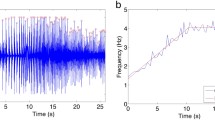Abstract
Using the spontaneously synchronized clapping in a concert hall as a special case, we build a nonlinear emergent model to characterize the collective behaviors of the complex multi-agent systems. Based on this model, we develop an experimental platform for emergent computation, which only depends on the local interaction and reveals the uncertainty and diversity of emergent behaviors. By analyzing the data in the procedure of many hands clapping, we find that there exists an obvious critical region generated in the procedure from disorder to synchronization. Moreover, we propose a fundamental synchronous criterion as follows: If the coupling coefficients c 1 and c 2 satisfy the condition 0.02⩽c 2⩽0.965c 1+0.018, then the clapping can realize synchronization.
Similar content being viewed by others
References
Holland J H. Emergence: From Chaos to Order. Rewood City, California: Perseus Books, 1998
Von Bertalanffy L. General System Theory: Foundations, Development, Applications (Revised edition). New York: George Braziller, 1973. 80–83
Huang D B. Synchronization-based estimation of all parameters of chaotic systems from time series. Phys Rev E, 2004, 69(6): 067201–067204
Huang D B. Identifying parameter by identical synchronization between different systems. Chaos, 2004, 14(1): 152–159
Reynolds C W. Flocks, herds, and schools: A distributed behavioral model. In: Proc ACM SIGGRAPH’87 Conf. Comput. Graph. Vol. 21. Anaheim, California: ACM Press, 1987. 25–34
Vicsek T, Czirok A, Jacob E B, et al. Novel type of phase transition in a system of self-driven particles. Phys Rev Lett, 1995, 75: 1226–1229
Néda Z, Ravasz E, Brechet Y, et al. The sound of many hands clapping—Tumultuous applause can transform itself into waves of synchronized clapping. Nature, 2000, 403: 849–850
Néda Z, Ravasz E, Vicsek T, et al. Physics of the rhythmic applause. Phys Rev E, 2000, 61(6): 6987–6992
Tesser A. Advanced Social Psychology. New York: McGraw-Hill Inc, 1995. 419–430
Zimbardo P G. The human choice: Individuation, reason, and order versus deindividuation, impulse, and chaos. In: Arnold W J, Levine D, eds. Nebraska Symposium on Motivation. Nebraska: University of Nebraska Press, 1970. 237–307
Li D Y, Du Y. Artifical Intelligence with Uncertainty (in Chinese). Beijing: National Defense Industry Press, 2005. 193–212
Wang Z K. Applications of the Probability (in Chinese). Beijing: Beijing Normal University Press, 1995. 152–158
Li D Y, Shi X M, Meng H J. Membership clouds and membership cloud generators. Comput Res Develop (in Chinese), 1995, 32(6): 15–20
Li D Y, Liu C Y. Study on the universality of the normal cloud model. Chinese Engin Sci (in Chinese), 2004, 6(8): 28–34
Zheng W M. Positive Feedback (in Chinese). Beijing: Tsinghua University Press, 1998. 118–122
Xu B M, Wang X L. An improved mix algorithm. Trans Electr Inf, 2003, 25(12): 1709–1713
Shannon C E. A mathematical theory of communication. Bell Syst Tech J, 1948, 27(6,10): 379–423, 623–656
Author information
Authors and Affiliations
Corresponding author
Additional information
Supported by the National Basic Research Program of China (Grant No. 2007CB310800), the National Natural Science Foundation of China (Grant Nos. 60375016, 60496323 and 60675032)
Rights and permissions
About this article
Cite this article
Li, D., Liu, K., Sun, Y. et al. Emergent computation: Virtual reality from disordered clapping to ordered clapping. Sci. China Ser. F-Inf. Sci. 51, 449–459 (2008). https://doi.org/10.1007/s11432-008-0046-9
Received:
Accepted:
Published:
Issue Date:
DOI: https://doi.org/10.1007/s11432-008-0046-9




